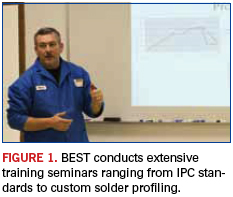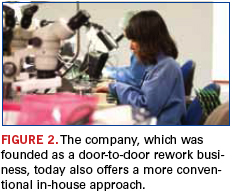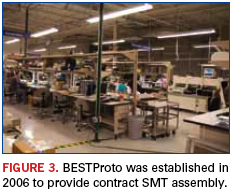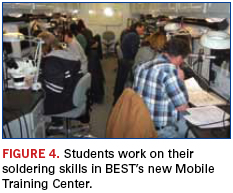BEST: On the Go
The EMS/repair depot/training center keeps rolling on.
Many are the number of successful companies launched in the founder’s garage. BEST got its start – literally – in a motor home.
It’s not how most executives would draw up their business plan, but that’s exactly how – or would that be where? – the now 16-year-old EMS company was launched: in a converted Winnebago.
The number of models for Tier IV EMS companies borders on infinite. Some offer straight consignment contract assembly. Others add turnkey services. Some specialize in repair. A few provide training certifications. Some have even ventured into distribution. That’s all in addition to the traditional work of assembling circuit boards, of course.
BEST (the acronym stands for Business Electronics Soldering Technologies) is one of the few that stretches the model in several directions, yet manages it so efficiently. The company still retains a sense of balance and focus. The firm takes a three-pronged approach, offering repair and reballing on a short-turn basis, training to IPC standards, and, most recently, an emerging turnkey EMS prototype-oriented operation. And it has diverged even further by developing its own line of dedicated rework stencils.
All of this takes place in a 24,500 sq. ft. building in Rolling Meadows, IL, just minutes from Chicago’s O’Hare International Airport. From the front, an otherwise nondescript building belies the flurry of activity going on inside. Inside, with three fully functioning businesses, space is at a premium.
Training has long been a steady business. The company is a Master Certification Solder Training Center for IPC-A-610, J-STD-001, IPC/WHMA-620 and IPC-7711/7721, and offers custom classes in SMT and rework.

New classes include ones for package-on-package (PoP) and thin silicon vias (TSV). Other non-standard courses include a five-day workshop on how to build a board, and classes on leadless device rework and profiling. BEST has developed its own test vehicles in order to ensure it matches real-world conditions. “We try to keep on top of the technology,” explains Bob Wettermann, chief executive and president of BEST.
At the Rolling Meadows site, it maintains a classroom with 10 stations for onsite instruction, but most (85%) of its training revenue is generated at remote locations. The company says it trains about 120 students a month, with an emphasis on methodology, not equipment. It boasts four trainers, all of whom are IPC Master Instructors.
The Winnebago was launched as a Mobile Training Center (MTC), a door-to-door service provider equipped with soldering equipment, stereo zoom microscopes, and all the presentation bells and whistles one might find in its Rolling Meadows classroom, a brick-and-mortar site. The firm’s expertise in training comes in part from its own in-house experience. Roughly 20% of BEST’s floor space in Rolling Meadows is dedicated to contract rework and repair. The company primarily uses Metcal QX2 and APR/5000 rework stations, I&J Fisnar dispensers, and Leica microscopes, supplemented by a pair of SRT 1000 repair machines. Component rework runs the gamut from BGA to more complex bottom-terminated components such as QFNs and LGAs. It handles repair orders numbering from a single board to thousands of pieces, fixing anything from video game boxes to Class 3 flight controls. A large repair order would be 150 to 200 pieces, but for component reballing, some orders run in the thousands.
BEST also has a full complement of testing and failure analysis equipment, including hi-pot, functional and electrical test, and diagnostic test. Other gear includes GenRad X-1525 x-ray.
In 2005, the firm added BESTProto to handle higher board volumes. Garth Cates, previously director of business development for EMS firm AG Communication Systems and an engineer with Lucent, was brought aboard to manage the new organization’s sales. The plant features MPM SPM screen printers, Mydata MY19 and MY100 pick-and-place machines, Vitronics Soltec XPM2 and XPM520 reflow ovens, and a small SnPb wave. Nordson YesTech AOI, a Camelot glue dispenser, a Grieve oven, and an Aqueous Technologies SMT 400-CL batch cleaner round out the equipment list. (Conformal coating jobs are sent out.)
“If there’s a word that describes BESTProto, it’s flexible,” says Cates. According to Cates, BEST conducts “a lot” of process development for customers.

Between the two companies, BEST has 36 fulltime employees. The firm is ISO 9001-2008 certified and also strictly follows ITAR procedures in order to maintain its registration: A certain Circuits Assembly reporter was relieved of his phone while touring the building.
BEST is one of only a few companies that offer contract rework, SMT assembly services and IPC training. But perhaps where BEST truly deviates from the Tier IV model is in its line of patented and branded products. They include everything from repair kits to rework stencils and preforms.
The repair kits are straightforward and include tools for fixing lands, traces, gold fingers, plated through-holes and board substrates. In addition to the equipment, the kits include “how to” instructional slides and videos on its website.
The stencils were sophisticated responses to market needs. They started with BGA rework, when the firm developed the StencilQuik, which reduces the time required to rework BGAs while repairing mask damage. A year later, in 2007, BEST announced the launch of the EZReball, a preform that simplifies the reballing process by eliminating the need for custom fixtures or frames, and holds solder balls in place until after reflow, then peels right off. In 2010 came the StencilMate, a line of polyimide stencils that “bump” leadless devices for easier placement. Also in 2010, the company invented the StikNPeel rework stencil, which is designed for tight spaces, and is ideal for reworking connectors and QFPs.

“All our products come from solving customer problems,” explains Hung Hoang, operations lead, BGA and Products, who invented the rework stencils. “EZReball is one of the products we sell. StencilQuik and StencilMate were solutions to a problem.” Such products undergo traditional evaluation and testing. “We test it out first, then send to a customer to beta test and to get feedback,” Hoang says. A NASA/DoD study recently demonstrated StencilMate performs at the same level as traditional board paste printing, while also holding up under thermal shock and vibration testing.1
It’s been a lucrative development; today, the company’s own product line is responsible for about 25% of its revenue.
It can be hard to live up to a name like BEST. Wettermann, who bought the company in 2002, has led a 10-year run of expansion into new markets and buildings, not to mention revenue growth, but clearly maintains his inner geek, sharing anecdote after anecdote about running the business, but getting most excited when one of his colleagues brings forward a complicated fix for a customer or an in-house invention.
As for the Winnebago, BEST donated it a few years ago to a California-based company that teaches PC skills to the underprivileged in San Diego and has replaced it with a larger, yet more economical, diesel-powered truck-based unit. It’s fitting for a company that, after 16 years, is still on the go.
References
1. Bob Wettermann, “Simple, Fast High-Reliability Rework of Leadless Devices,” CIRCUITS ASSEMBLY, August 2012.
Mike Buetow is editor in chief of CIRCUITS ASSEMBLY (circuitsassembly.com); mbuetow@circuitsassembly.com.







